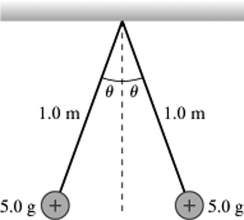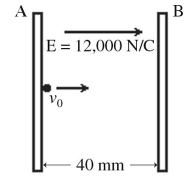A) 6.9 × 106 N/C
B) 7.8 × 105 N/C
C) 1.5 × 106 N/C
D) 2.1 × 106 N/C
Correct Answer

verified
Correct Answer
verified
Multiple Choice
Three equal negative point charges -q are placed at three of the corners of a square of side d as shown in the figure.Which one of the arrows shown represents the direction of the net electric field at the vacant corner of the square? 
A) A
B) B
C) C
D) D
Correct Answer

verified
Correct Answer
verified
Multiple Choice
 X and Y are two initially uncharged metal spheres on insulating stands,and they are in contact with each other.A positively charged rod R is brought close to X as shown in part (a) of the figure.Sphere Y is now moved away from X,as shown in part (b) .What are the final charge states of X and Y?
X and Y are two initially uncharged metal spheres on insulating stands,and they are in contact with each other.A positively charged rod R is brought close to X as shown in part (a) of the figure.Sphere Y is now moved away from X,as shown in part (b) .What are the final charge states of X and Y?
A) Both X and Y are neutral.
B) X is positive and Y is neutral.
C) X is neutral and Y is positive.
D) X is negative and Y is positive.
E) Both X and Y are negative.
Correct Answer

verified
Correct Answer
verified
Multiple Choice
An asteroid of mass 58,000 kg carrying a negative charge of  Is
Is  From a second asteroid of mass
From a second asteroid of mass  Carrying a negative charge of
Carrying a negative charge of  What is the magnitude of the net force the asteroids exert upon each other,assuming we can treat them as point particles? (G = 6.67 × 10-11 N ∙ m2/kg2,k = 1/4 πε0 = 8.99 × 109 N ∙ m2/C2)
What is the magnitude of the net force the asteroids exert upon each other,assuming we can treat them as point particles? (G = 6.67 × 10-11 N ∙ m2/kg2,k = 1/4 πε0 = 8.99 × 109 N ∙ m2/C2)
A) 0.000040 N
B) 0.0062 N
C) 570,000 N
D) 510,000 N
Correct Answer

verified
Correct Answer
verified
Multiple Choice
A solid aluminum cube rests on a wooden table in a region where a uniform external electric field is directed straight upward.What can we say concerning the charge on the top surface of the cube?
A) The top surface is charged positively.
B) The top surface is charged negatively.
C) The top surface is neutral.
D) The top surface's charge cannot be determined without further information.
Correct Answer

verified
Correct Answer
verified
Multiple Choice
The figure shows two tiny 5.0-g spheres suspended from very light 1.0-m-long threads.The spheres repel each other after each one is given the same positive charge and hang at rest when θ = 4.1°.What is the charge on each sphere? (k = 1/4πε0 = 9.0 × 109 N ∙ m2/C2) 
A) 22 nC
B) 89 nC
C) 360 nC
D) 180 nC
E) 45 nC
Correct Answer

verified
Correct Answer
verified
Multiple Choice
Two very small plastic balls of equal mass are released from rest.One of them carries +10 µC of excess charge and the other one carries +1µC of charge.No other charges or fields are present.Which of the following statements are true about them as they move away from each other? (There may be more than one correct choice. )
A) The acceleration of the 10-µC ball is 10 times that of the 1-µC ball.
B) The acceleration of the 1-µC ball is 10 times that of the 10-µC ball.
C) The balls always have accelerations of equal magnitude.
D) The speed of the balls keeps increasing.
E) The acceleration of the balls keeps increasing.
Correct Answer

verified
Correct Answer
verified
Multiple Choice
A pair of charged conducting plates produces a uniform field of 12,000 N/C,directed to the right,between the plates.The separation of the plates is 40 mm.An electron is projected from plate A,directly toward plate B,with an initial speed of v0 = 2.0 × 107 m/s.What is the speed of the electron as it strikes plate B?  ,melectron = 9.11 × 10-31 kg)
,melectron = 9.11 × 10-31 kg) 
A) 1.2 × 107 m/s
B) 1.5 × 107 m/s
C) 1.8 × 107 m/s
D) 2.1 × 107 m/s
E) 2.4 × 107 m/s
Correct Answer

verified
Correct Answer
verified
Multiple Choice
The figure shows two unequal charges,+q and -Q.Charge -Q has greater magnitude than charge +q.Point X is midway between the charges.In what section of the line will there be a point where the resultant electric field is zero? 
A) VW
B) WX
C) XY
D) YZ
Correct Answer

verified
Correct Answer
verified
Multiple Choice
A +5.00-μC point charge is placed at the 0.0 cm mark of a meter stick and a -4.00-μC point charge is placed at the 50.0 cm mark.At what point on a line through the ends of the meter stick is the electric field equal to zero?
A) 1.4 m from the 0 cm mark
B) 2.5 m from the 0 cm mark
C) 2.9 m from the 0 cm mark
D) 3.3 m from the 0 cm mark
E) 4.7 m from the 0 cm mark
Correct Answer

verified
Correct Answer
verified
Multiple Choice
A hydrogen nucleus,which has a charge +e,is situated to the left of a carbon nucleus,which has a charge +6e.Which statement is true?
A) The electrical force experienced by the hydrogen nucleus is to the left,and the magnitude is equal to the force exerted on the carbon nucleus.
B) The electrical force experienced by the hydrogen nucleus is to the left,and the magnitude is greater than the force exerted on the carbon nucleus.
C) The electrical force experienced by the hydrogen nucleus is to the left,and the magnitude is less than the force exerted on the carbon nucleus.
D) The electrical force experienced by the hydrogen nucleus is to the right,and the magnitude is equal to the force exerted on the carbon nucleus.
Correct Answer

verified
Correct Answer
verified
Multiple Choice
Two tiny particles having charges of +5.00 μC and +7.00 μC are placed along the x-axis.The +5.00-µC particle is at x = 0.00 cm,and the other particle is at x = 100.00 cm.Where on the x-axis must a third charged particle be placed so that it does not experience any net electrostatic force due to the other two particles?
A) 4.58 cm
B) 45.8 cm
C) 50 cm
D) 9.12 cm
E) 91.2 cm
Correct Answer

verified
Correct Answer
verified
Multiple Choice
The electric field at point P due to a point charge Q a distance R away from P has magnitude E.In order to double the magnitude of the field at P,you could
A) double the distance to 2R.
B) double the charge to 2Q.
C) reduce the distance to R/2.
D) reduce the distance to R/4.
E) double the charge to 2Q and at the same time reduce the distance to R/2.
Correct Answer

verified
Correct Answer
verified
Multiple Choice
The force of attraction that a -40.0 μC point charge exerts on a +108 μC point charge has magnitude 4.00 N.How far apart are these two charges? (k = 1/4πε0 = 8.99 × 109 N ∙ m2/C2)
A) 2.10 m
B) 3.67 m
C) 3.12 m
D) 2.49 m
E) 1.13 m
Correct Answer

verified
Correct Answer
verified
Multiple Choice
An electron and a proton are released simultaneously from rest and start moving toward each other due to their electrostatic attraction,with no other forces present.Which of the following statements are true just before they are about to collide? (There could be more than one correct choice. )
A) They are closer to the to the initial position of the electron that to the initial position of the proton.
B) They are closer to the to the initial position of the proton that to the initial position of the electron.
C) They are at the midpoint of their initial separation.
D) They both have the same speed.
E) The electrostatic force on the proton is greater than the electrostatic force on the electron.
Correct Answer

verified
Correct Answer
verified
Showing 61 - 75 of 75
Related Exams